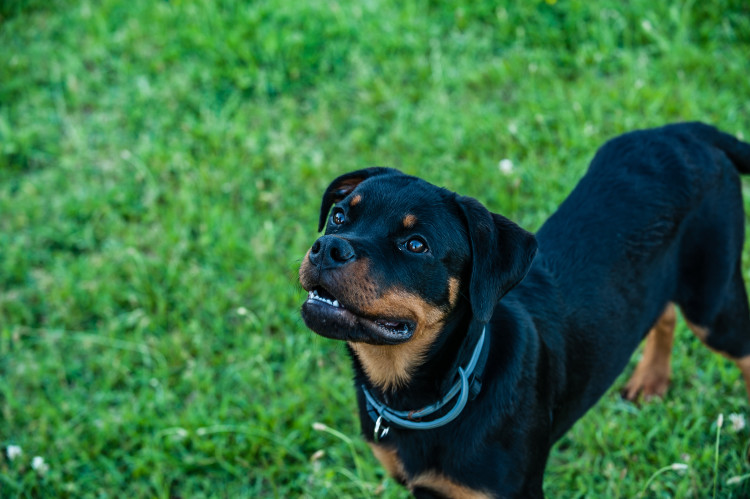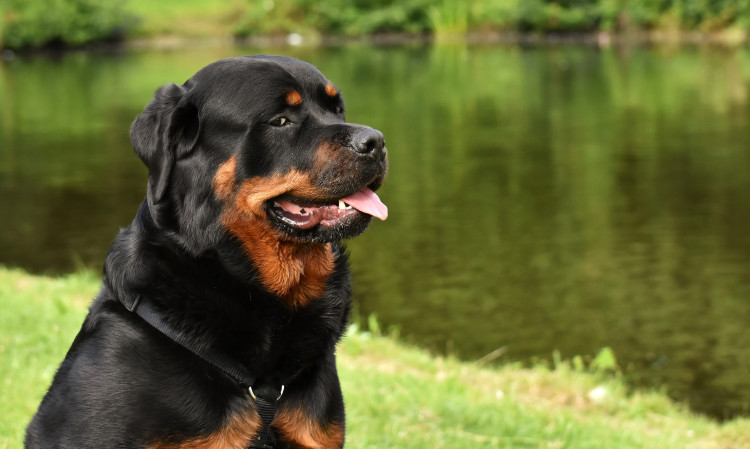Originally bred as working dogs, Rottweilers traveled with conquering Roman legions. They were used to herd livestock but quickly became popular for police work, search and rescue and as guide dogs for the blind. As descendants of the massive Asian Mastiff, it should come to no surprise that this loyal dog breed is quite large themselves. As a loving “Rottie” pet parent, you may be asking yourself how large can a Rottweiler grow and how do I know when my Rottweiler is finished growing?
Everything you need to know about Rottweiler growth:
- Male Rottweiler Growth & Weight Chart
- Female Rottweiler Growth & Weight Chart
- Rottweiler Height Chart
- At what age is a Rottweiler fully grown?
- How big should a 6-month-old Rottweiler be?
- How much bigger will my Rottweiler get?
- What is the size of a full-grown Rottweiler?
- How do I make sure my Rottweiler Is healthy?
Rottweiler Growth & Weight Chart
Rottweilers are large, muscular dogs who grow to be fierce, loving protectors. As shown in the charts below, their weight can vary significantly based on gender. Keep in mind that the following numbers are estimates to give you an idea of their size at particular ages. Don’t worry if your Rottweiler is a little behind or ahead of the following numbers. Keep taking your Rottweiler to their veterinarian to make sure they are growing healthy and strong!
Pro Tip: Ready to be reimbursed for up to 90% of your dog’s veterinary bills whenever they are sick or injured? Compare Rottweiler health insurance options now. Pet insurance can help you provide your Rottweiler with the best quality veterinary care today!
Male Rottweiler Growth and Weight Chart
| Age | Weight |
|---|---|
| 1 month | 4 - 8 lbs |
| 2 months | 12 - 16 lbs |
| 3 months | 34 - 39 lbs |
| 4 months | 44 - 51 lbs |
| 5 months | 54 - 61 lbs |
| 6 months | 64 - 71 lbs |
| 7 months | 72 - 80 lbs |
| 8 months | 75 - 85 lbs |
| 9 months | 90 - 105 lbs |
| 10 months | 95 - 110 lbs |
| 11 months | 95 - 115 lbs |
| 1 year | 95 - 125 lbs |
| 1.5 years old | 95 - 135 lbs |
| 2 years | 95 - 135 lbs |
Female Rottweiler Growth and Weight Chart
| Age | Weight |
|---|---|
| 1 month | 3 - 6 lbs |
| 2 months | 10 - 14 lbs |
| 3 months | 30 - 35 lbs |
| 4 months | 35 - 42 lbs |
| 5 months | 45 - 55 lbs |
| 6 months | 59 - 64 lbs |
| 7 months | 65 - 70 lbs |
| 8 months | 70 - 75 lbs |
| 9 months | 70 - 80 lbs |
| 10 months | 75 - 85 lbs |
| 11 months | 75 - 90 lbs |
| 1 year | 80 - 95 lbs |
| 1.5 years old | 80 - 100 lbs |
| 2 years | 80 - 100 lbs |
Rottweiler Height Chart
Male and female Rottweilers differ in how much they weigh, but are usually close in height. The following numbers are estimates for how tall your Rottweiler may be at certain ages. To measure your pup’s height, measure from the ground to the top of your standing dog’s shoulders.
| Age | Height |
|---|---|
| 8 weeks | 13 inches |
| 10 weeks | 15 inches |
| 3 months | 18 inches |
| 4 months | 20 inches |
| 5 months | 22 inches |
| 6 months | 22 - 23 inches |
| 7 months | 22 - 25 inches |
| 8 months | 22 - 25 inches |
| 9 months | 22 - 26 inches |
| 1 year | 22 - 27 inches |
| 2 years | 22 - 27 inches |
At what age is a Rottweiler full grown?
As a large-sized dog breed, Rottweilers take longer than many dogs to reach their full size. You can expect a Rottweiler to reach their maximum height around one year old and their total weight around two years old. Larger Rottweilers may need up to a full three years to finish filling out to their final adult weight.
As a general rule, if your Rottweiler is one year old or older, they are probably close to their full weight and are likely at their adult height.

(Image Source: Canva)
How big should a 6-month-old Rottweiler be?
Like many large dog breeds, Rottweilers will have their most intense growth spurt between five to seven months old.
A male six-month-old Rottweiler will weigh between 64 and 71 pounds on average, with their female counterpart weighing in around 60 to 64 pounds. Both pups will stand about 22 to 23 inches in height, which is only a few inches shy of their maximum adult height though the shortest Rottweilers may stop growing at 22 to 23 inches.
Pro Tip: Check out this downloadable new puppy checklist covering topics like vaccination schedules, training, teething, veterinary appointments, and more!
How much bigger will my Rottweiler get?
There are a few ways to estimate how much bigger your Rottweiler will grow.
As large dogs, Rottweilers take longer to reach their full size compared to smaller dog breeds. You can expect your Rottweiler to reach their full height around one year of age. At one year old, most Rottweilers will be close to their full size. However, it may take them until two to three years old to fully reach their final weight.
Another way to estimate their full size is to contact your Rottweiler’s breeder. Many breeders can give you a more precise estimate based on previous litters and your Rottie’s parents’ height and weight. A puppy will rarely grow larger than either parent, so this will give you a more accurate idea of their maximum size.
You can also take a look at your Rottweiler’s paws. Do their paws look too big when compared to their legs and the rest of their body? This is a classic puppy feature and sign that your Rottweiler is still growing and filling out!
What is the size of a full-grown Rottweiler?
According to the American Kennel Club Official Rottweiler Standards, Rottweilers should appear longer than tall. Male Rottweilers should fall between 24 to 27 inches tall, weighing in at 95 to 135 pounds. In comparison, female Rottweilers are slightly smaller at 22 to 25 inches tall and 80 to 100 pounds.
These numbers are estimates, and some Rottweilers will be smaller or larger based on their genetics and environment. The most important thing is that your Rottweiler is happy and healthy!
 (Image Source: Canva)
(Image Source: Canva)
How do I make sure my Rottweiler is healthy?
Prevention is always better than treatment. Regular veterinary appointments are crucial for keeping up with your Rottweiler’s x-rays, vaccinations, and the screening and prevention of disease. Like all dogs, especially purebreds, Rottweilers are prone to certain genetic diseases.
Rottweilers are especially prone to hip dysplasia. According to the Veterinary Centers of America, Rottweiler puppies should be fed large-breed specific puppy food. This has been shown to decrease the occurrence and severity of hip dysplasia based on unique important nutrients in this type of diet. If you are unsure about what brand of food is best for your Rottie puppy, your veterinarian will happily discuss diet and nutrition with you! As a whole, Rottweilers do not tend to gain excess weight but they should still be fed a well-balanced diet in appropriate amounts and have the opportunity for daily exercise.
Rottweilers are also commonly affected by heart disease, like aortic stenosis, which occurs when the aortic valve narrows, forcing the body to strain to force blood through the narrowed valve. The additional strain can damage the heart, leading to muscle failure and potential death.
Emergencies and treatment for diseases, like aortic stenosis, can quickly become expensive. Only 19.44% of pet parents surveyed would be able to cover a $5,000 veterinary expense out-of-pocket, leaving the other pet parents in a compromising place, where they would need to borrow or seek out financing options. This is why pet insurance is so vital to pet parents, especially of purebred dogs with possible genetic disease predisposition. When the worst happens, pet insurance gives you peace of mind and allows you to focus on what’s truly important - your dog’s wellbeing and happiness.
Dog Insurance is a smart investment that helps you cover the cost of emergencies, accidents, and disease. Many dog insurance plans also offer wellness coverage that will reimburse you for up to 90% of your dog’s healthy veterinary check-ups, vaccinations, and other routine care to prevent larger medical emergencies.
Final Considerations
At the end of the day, your veterinarian is your best resource in taking care of your precious Rottweiler. Not only can your veterinarian provide personalized recommendations for their health, but they can perform diagnostic work ups, treat any ailments, injuries, or diseases that surface, and help you make the best choices in caring for your pup at home.
As doting pet parents, we never want to think that the worst could happen to our dog. It’s terrible to think about, but pet insurance gives you the peace of mind in knowing that your dog is covered should the worst happen. With quality insurance coverage, you and your veterinarian will be able to provide your pup with gold standard medical care regardless of the cost, to keep your Rottie happy and healthy!
Pawlicy Advisor is here to help. Let us do the work of comparing pet insurance plans for you so that you can pick the best plan for you and your pup.
Click here to find the best dog health insurance and save big over your dog’s lifespan today!
